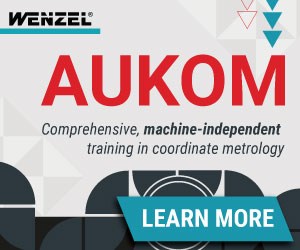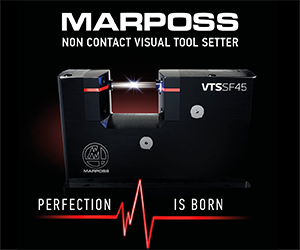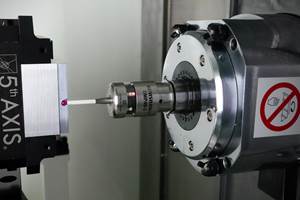Using Augmented Reality on the Shopfloor
As the technology behind virtual reality comes into its own, companies are already looking at how manufacturers can make use of it.
As a staple of films like “Total Recall” and “The Matrix,” virtual reality is slowly making its way out of the realm of science fiction and into the reality of the manufacturing workplace. Virtual reality (VR) is a computer simulation that is designed to replicate a “real-world” experience. While a film can project real images onto a screen, a VR system is designed to trick your brain into thinking you are part of the action.
The essential interface of most VR systems is a headset that projects visual information on a screen directly in front of the eyes. By turning the head, the user changes the perspective of the footage on the VR screen. One VR program, for example, simulates a sweeping view from the Smoky Mountains, enabling the user to guide the camera by turning his or her head.
Using this technology, augmented reality (AR) programs project digital information over the user’s real-world vision to highlight objects and provide information to that person. If, for example, someone was watching a baseball game using an AR system, a yellow line could track a pitched ball while the scoreboard information was displayed to the side, including the count and pitch speed. All this added information would appear in front of the user’s eyes, to augment the experience of watching the game and make it more engaging. Cemtrex VR (Farmingdale, New York) has been developing this technology for use in manufacturing environments under the name WorkbenchVR, with a focus on improving assembly workflow. Instead of watching baseball, AR could be used to watch components come together to form a completed product.
Though still in its beta stage, the company’s AR system is one of the few technologies exploring how AR feedback can improve the capabilities of the manufacturing process. The system uses CAD files to map objects into its virtual interface. Essentially, by uploading the CAD files of the individual pieces of an assembly, the headset can identify them in the real world and highlight them for the user. Theoretically, it would be able to guide the user through assembly and identify any problems such as faulty pieces.
According to Cemtrex CEO Saagar Govil, WorkbenchVR will serve multiple functions in the manufacturing world:
Assembly – As more job shops offer assembly services to their customers, this system enables machine shop employees to identify unfamiliar parts and assemble finished products. The system, once finished, will be able to highlight parts and walk the user through the process with simple instructions that project across the headset. The system could also show shopfloor employees how to put together pieces of a modular fixturing system to speed a machining setup. Showing employees how to arrange components in preconfigured kits for downstream assembly or direct delivery to a customer’s assembly station is another likely application.
Instruction – Guided training modules can acclimate new team members to the work environment and teach them how to use the equipment. The system can highlight next steps and remind employees of best practices until they are proficient at tasks and have mastered procedures.
Inspection – The system can improve inspection processes by projecting digital images of the designed part for the inspector to compare with the finished product. Apparent discrepancies or deviations can be recognized and designated for closer examination. For example, missing holes or incomplete part features could be spotted more readily. Likewise, setups and fixturing could be verified almost at a glance.
Maintenance – AR technology will be able function as an interactive manual for performing maintenance and repair. In time, it will be able to identify problem areas and highlight them on the user’s headset, shortening repair time and improving the results. For example, while examining a machine’s subsystems, the viewer’s headset display could highlight points of wear to be checked or flag trouble indicators for monitoring.
Workflow – By enabling the user to set specific instructions for the workflow of a job, the system could enable shops to avoid mistakes from oversights or missed steps.
Although the system currently is being tested at large factories with high volumes and many employees, Mr. Govil believes that the technology ultimately will be accessible to smaller manufacturers. “Anyone who frequently needs to quickly identify and process unfamiliar parts can benefit from AR,” he says. Furthermore, he says that it is inevitable that manufacturers will incorporate similar technology into their businesses because AR is a means to empower employees and enhance the application of their skills and judgment.
While the technology shows great promise, it faces several technical challenges, including the need for greater standardization and interoperability. According to Mr. Govil, the company is still improving the system’s object-identification capability and modifying headsets to make them more comfortable for extended wear.
Related Content
6 Machine Shop Essentials to Stay Competitive
If you want to streamline production and be competitive in the industry, you will need far more than a standard three-axis CNC mill or two-axis CNC lathe and a few measuring tools.
Read MoreUnderstanding Errors In Hand-Held Measuring Instruments
Different instruments (and different operators) are prone to different errors.
Read MoreA Case for Combining Workholding with Optical Scanning
Automotive dies and die inserts are often complex, one-off parts with little room for error. Integrity Tool's investments in modular workholding tools and 3D optical scanning have allowed the company to create niche capabilities for its CNC machined parts.
Read MoreWhat Should Machinists Know About In-Machine Probing?
In-machine probing doesn’t reach the power of CMMs but can still be useful for pre- and mid-process control, as well as for “rough screening” of parts.
Read MoreRead Next
Obscure CNC Features That Can Help (or Hurt) You
You cannot begin to take advantage of an available feature if you do not know it exists. Conversely, you will not know how to avoid CNC features that may be detrimental to your process.
Read MoreUsing Automation to Reduce COGS and Stay Globally Competitive
Decade-long, multiphase automation investments lower operating costs and maintain technology lead in an increasingly competitive global market.
Read More3 Mistakes That Cause CNC Programs to Fail
Despite enhancements to manufacturing technology, there are still issues today that can cause programs to fail. These failures can cause lost time, scrapped parts, damaged machines and even injured operators.
Read More










.png;maxWidth=300;quality=90)






.png;maxWidth=300;quality=90)








